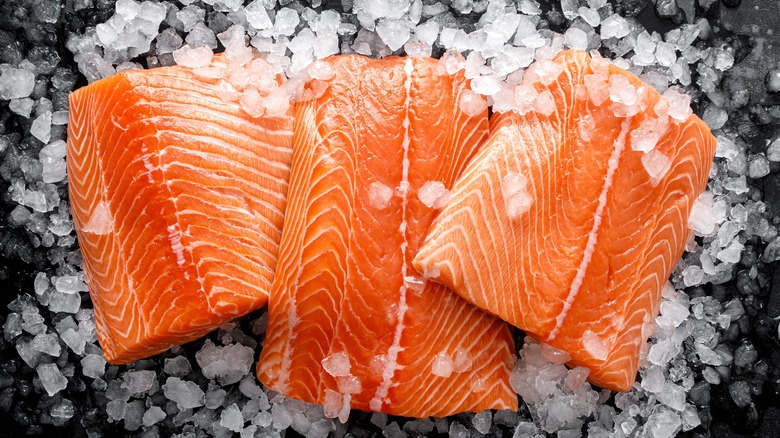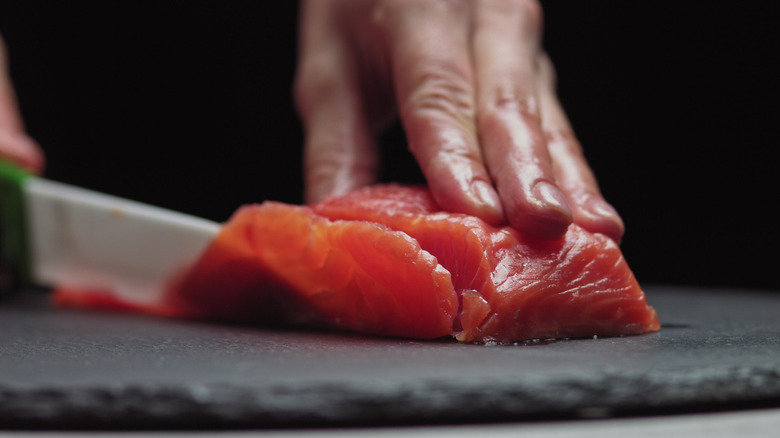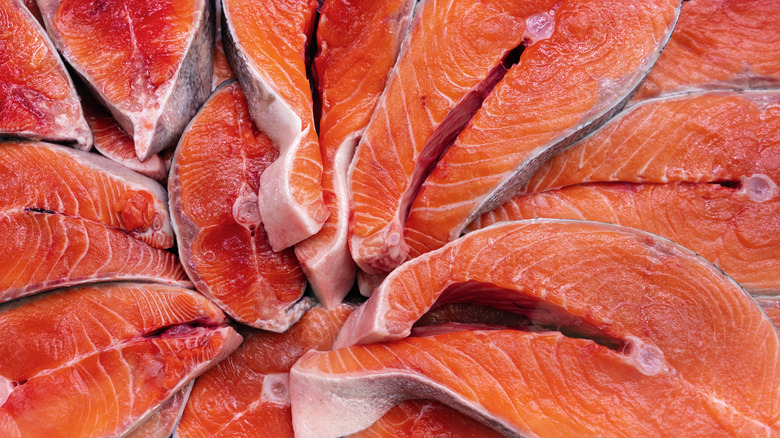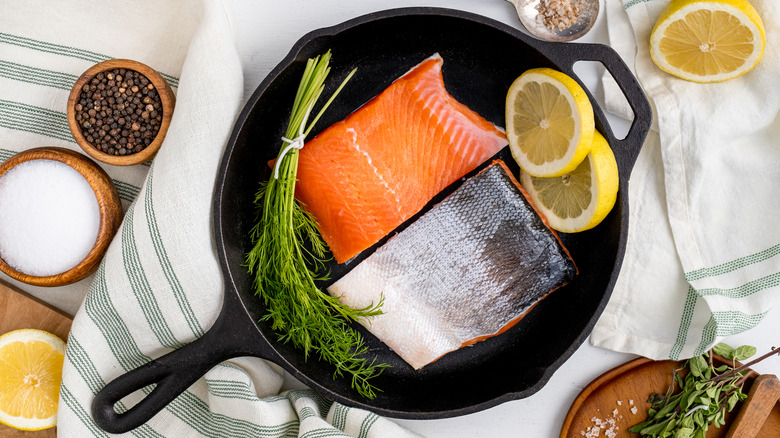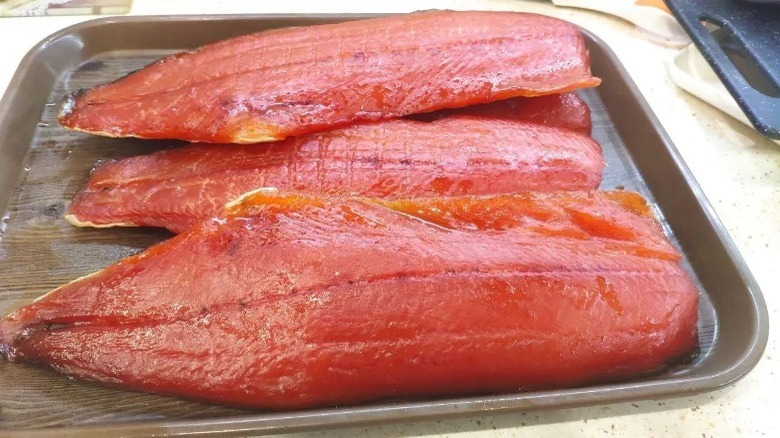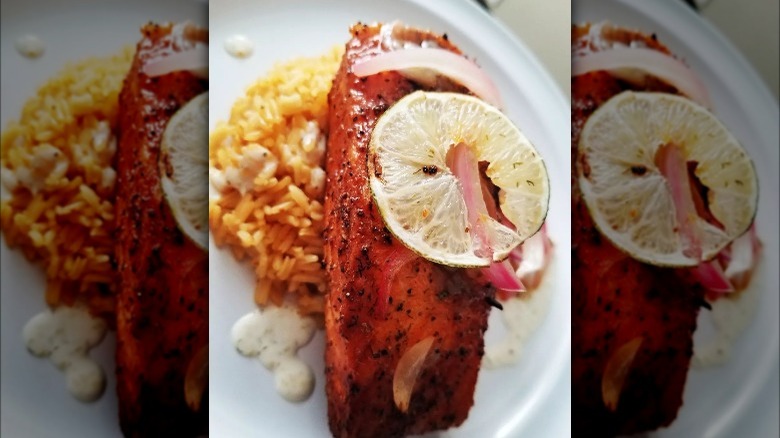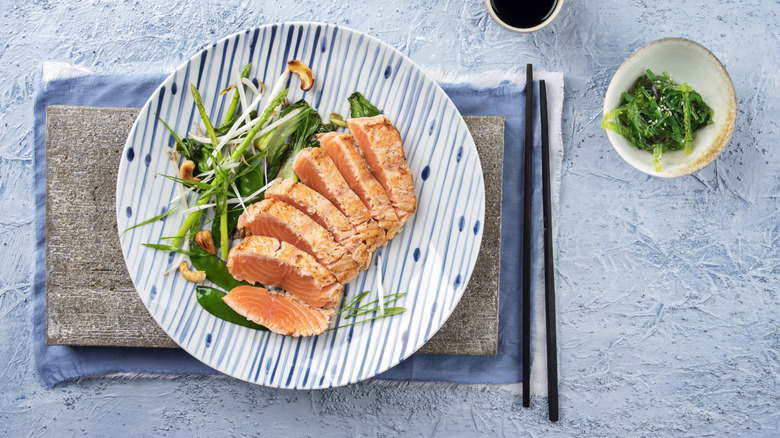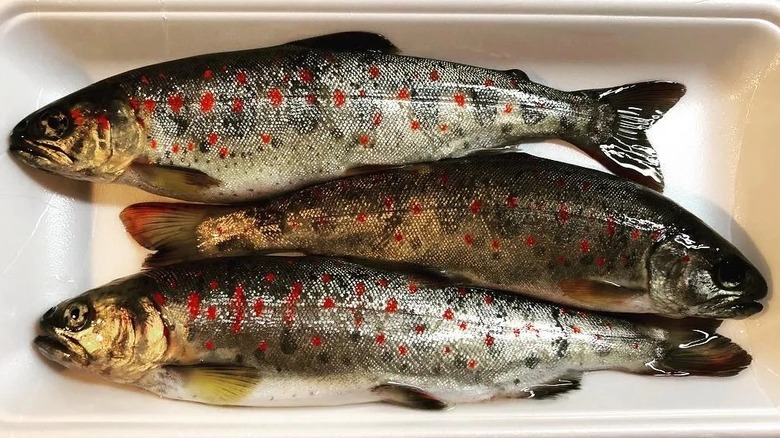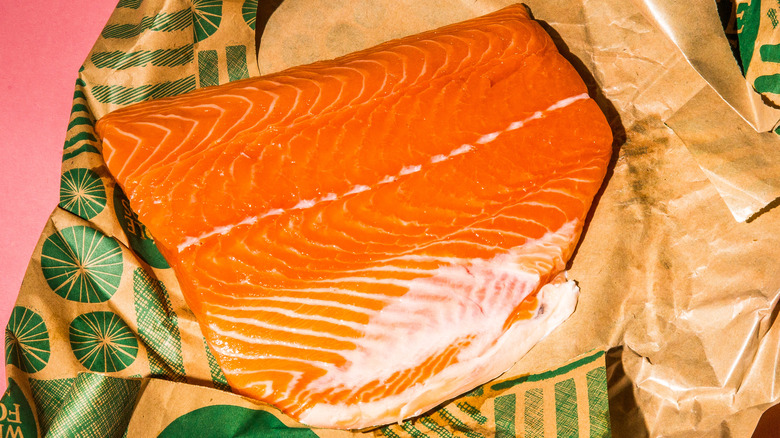8 Types Of Salmon And How To Cook Them
Salmon is by no stretch of the imagination an exotic good; you can find its signature pink flesh brightening up the seafood aisle in grocery stores across the country. According to a 2021 article from National Geographic, salmon holds the title of most popular fish in the United States. But there is more to this ubiquitous fish than meets the eye during a supermarket browse.
There are eight known species of salmon, according to the U.S. Geological Survey. That includes one Atlantic breed and seven species of Pacific salmon — five of which can be found in the North American waters of the eastern Pacific. The other two Pacific breeds hail from Asia. Salmon is generally very high in fat which results in a rich, oily flavor — however, salmon's taste does vary by species, how and where it was raised or farmed, and the time of year it was harvested (via Chef's Pencil).
One thing all salmon species have in common, though? They are absolutely delicious when cooked the right way. And luckily for home chefs of all skill levels, there are a multitude of ways to treat this fatty fish right. Mashed took a closer look at the eight different types of salmon, why each one is delectable in its own right, and the best ways to prepare them so they shine on the plate and in your mouth.
Sockeye salmon
Sockeye is among the most prolific varieties of salmon in North America. The name sockeye is actually a phonetic translation of suk-kegh from the native Coast Salish language of British Columbia. Suk-kegh means "red fish," which certainly makes more sense than sockeye — these salmon appear blue in salt water to blend in with their surroundings, but change to a reddish hue as they swim to freshwater to spawn. They are among the smaller of the Pacific salmon types, averaging about 2.5 feet in length, and weighing between 5 and 15 pounds (via National Geographic).
Chef's Resources refers to sockeye salmon as the firmest, reddest, and most flavorful in the Pacific. The site also mentions that sockeye salmon is very fatty, which makes for an especially filling meal. Because of sockeye's bold and intense flavor, it's well suited for very simple preparation methods that don't overshadow its natural taste and texture. As such, eating it raw in the form of sushi is a very popular way to enjoy this fish. In fact, sushi blog Ichi Sushi reports that sockeye is the most common type of salmon you'll find in sushi restaurants. But sockeye need not just be enjoyed raw. As Global Seafood notes, smoked sockeye is mouthwatering, and the salmon is also delicious when cured to make lox.
Chinook
Chinook salmon is a sight to behold and hard to miss. The largest Pacific salmon variety, it's also known as king salmon, and for good reason. Each fish averages around 30 pounds in weight and 3 feet in length, though some can get much larger than that (via the National Wildlife Federation). The Alaska Department of Fish and Game notes the biggest Chinook on record weighed a whopping 126 pounds — and perhaps there's a king of the king salmons that's still yet to be reeled in. Chinook salmon mostly live in the waters of the Pacific Northwest all the way up to Alaska, though some can also be found in Russia and Japan, according to NWF. In the last 50 years or so, Chinook have also become the most abundant salmon species introduced in the Great Lakes (per Michigan Department of Natural Resources).
Chinook, or king salmon, lives up to its name with a very luxurious taste and soft, flaky texture. It is the fattiest of all salmon varieties, with the highest heart-healthy omega-3 content. Chef's Resources describes it as velvety and succulent, with a mild yet very rich flavor. Another reason Chinook is the king of all salmon: It can stand up to a range of cooking methods and stand out in a variety of recipes (via Skipper Otto). It's great on the grill, stands up to smoking, and loves to be slow-cooked or roasted.
Coho
For those considering the environmental impact of the salmon they consume, coho may be the best bet. The National Oceanic and Atmospheric Administration (NOAA) says this salmon variety is "responsibly harvested under U.S. regulations," and notes that action has been taken to ensure the commercial, recreational, and tribal fishing of coho is as sustainable as possible. Furthermore, there is currently a much higher population of wild coho salmon than other more endangered varieties of salmon, like wild Atlantic salmon. So you can feel good about chowing down on this sustainable fish.
Coho salmon (also called silver salmon due to its coloring) has a milder, more "dialed back" flavor that most other varieties, and a firm texture that lends itself well to a spectrum of cooking styles (via Wild Alaskan Company). But it's worth noting that, compared to other species of salmon, coho has slightly lower fat levels, so it's easier to overcook and thus dry it out. For this reason, the fish aficionados at Wild Alaskan Company say poaching is one of the best ways to cook coho salmon. A quick pan sear or broil in the oven also works well, resulting in a moist piece of fish that's perfectly crispy on the outside, if done right. Fillets are typically in season from July to October, and you'd be remiss to skip out on the chance to try this fish in its prime – Fish Choice says coho has been called "one of the best-tasting salmon."
Chum salmon
One of the lesser-known salmon varieties, chum is a meaty and delicious fish that's worth getting to know. While its name may be off-putting, it actually has nothing to do with fish bait — chum is actually a roughly translated reference to the distinctive markings on the fish's body (via FooDB). And in fact, if you enjoy indulging in fancy foods, you've probably eaten chum without even realizing it, as chum salmon caviar is extremely popular and highly prized (via Global Seafoods).
Similar to coho, wild-caught chum is sustainably harvested, so it's a smart supermarket choice, if you can find it (via NOAA). The Alaska Department of Fish and Game notes that chum salmon has long been used in the region as a dried winter food, and is often sold in smoked and canned forms. Chum fillets are considerably low in fat, high in micronutrients, and have a very mild taste. Skipper Otto suggests chum salmon for those who don't like an intense fish flavor, and says it works well in curries and chowders. They also suggest making chum burgers for the more adventurous and adept in the kitchen.
Pink salmon
One of the smallest species of salmon, pink salmon usually weigh no more than 5 pounds (via the Alaska Department of Fish and Game). This particular type of salmon is found in abundance, primarily in the frigid waters of the northern Pacific. The tiny fish is unmistakable with its bright green to blue scales, as well as the black spots it develops in freshwater — not to mention its telltale pink flesh. Pink salmon is less commercially viable than most other species, partly because of just how plentiful it is, and also due to its size and low oil content (via the National Park Service). Pink salmon is typically harvested in huge quantities and then canned, smoked, or processed into nuggets and other prepared foods.
However, that's not to say it's impossible to have a good pink salmon fillet. When it comes to cooking, the foodies at Kitsilano.ca suggest pink salmon should really be handled more like a trout than anything else. Some say pink salmon is the most delicate when it comes to taste and should be grilled with the skin-side down to retain its flavor. As the site notes, curing, steaming, or poaching are all well suited for this quieter variety.
Cherry salmon
Though the Eastern Pacific, which hugs the West Coast of the United States, holds the most varieties of salmon, it's not the only place to find them. The western Pacific is home to two varieties of salmon that have found favor with fishermen and foodies alike. One of them is known as cherry salmon. Dominant in the cold waters of Japan, this species is classified as either masu or yamame, depending on the salmon's habitat. As Fly Fisherman explains, cherry salmon that live solely lived in landlocked bodies of freshwater are referred to as yamame. Anadromous cherry salmon that migrate from saltwater to freshwater are known as masu. Unlike pink salmon, the masu's name does not only refer to its rosy pink flesh; masu salmon tend to be found in rivers as the cherry blossoms bloom (via Fly Fisherman).
Cherry salmon are similar to pink salmon and only weigh on average a petite 5.5 pounds (via Wild Salmon Center). Umaimono Aomori describes this salmon's flavor as both refined and luscious. It attributes this to the fact that the melted snow water of two Japanese mountains feed seasonally into the same sea where masu congregate. Presumably, these are some of the same mountain rivers that feed yamame (via World Natural Heritage). Despite being pretty fatty, masu has a light flavor, and there are several great ways to prepare it — try grilling, pan frying, or even making masu sushi.
Amago
It remains debated whether or not cherry salmon and amago are basically one and the same, or two different varieties of salmon. Fly Fisherman does their best to clear up these murky waters, and says there is good reason to differentiate between the two. While cherry salmon are from the Eastern drainages of Japan, amago come from the West. Additionally, amago have small red and bright orange dots that are simply not found on the other Western Pacific fish.
Amago translates to rain child, alluding to the fact that the salmon's migration coincides with the beginning of the Japan's rainy season. Amago is also known the queen of riverfish – perhaps this alludes to the fish's unique appearance, but it's just as understandable when it comes to its taste. In Japan, amago is often enjoyed as sashimi. Another stellar traditional recipe is nanbanzuke, which calls for marinating the fish in a tangy sauce and deep-frying it. And apparently, even amago bones are delicious.
Atlantic salmon
The only salmon to be found in the Atlantic, as one might be able to guess from the name, the Atlantic salmon also holds claim to the prestigious nickname "King of Fish". This salmon variety, which finds home in the frigid waters of upper North America to western Europe, weighs around 10 pounds on average (via NOAA). Though it isn't uncommon to find one coming in at 30 pounds.
Due to their protected status, you won't find any wild-caught Atlantic salmon — only farmed Atlantic salmon can be legally harvested (via NOAA). And there are a few unique aspects that come with farm-raised salmon. Seafood Source notes that farmed Atlantic salmon has an orange to pinkish hue — which it retains even when cooked — and while it is only moderately oily, it has a marbly fattiness and a sturdy texture.
As Tasting Table notes, Atlantic salmon is a readily available, go-to salmon option for a plethora of recipes. Keep it simple and stick to the basics with this fish. Place it flesh-side down and give it a good sear in a neutral cooking oil. Additionally add salt and pepper, as well as other seasonings to get as creative as your heart desires. A twist of lemon on the freshly cooked filet is always the perfect finishing note. And Seafood Source recommends not overpowering the salmon, suggesting a dill and yogurt sauce, cucumbers, and potatoes as perfect companions to the farmed fish.
